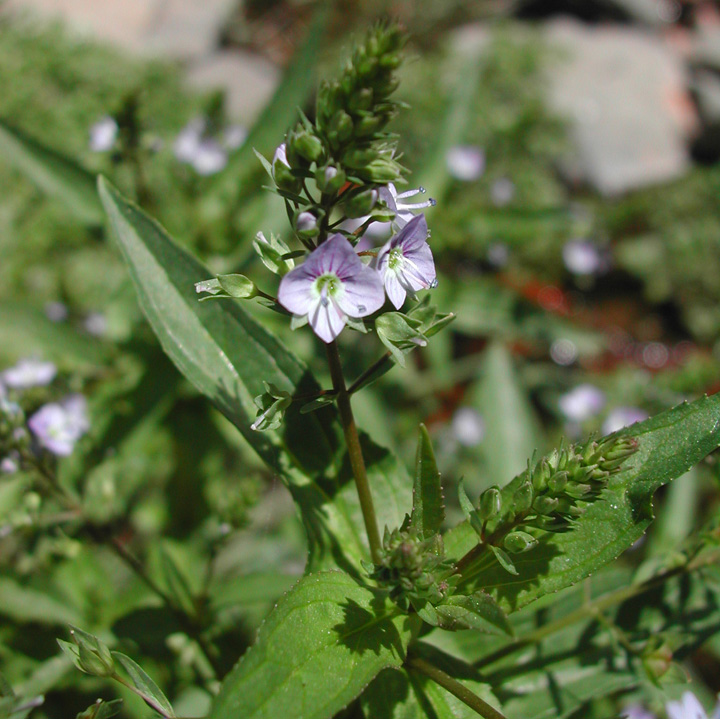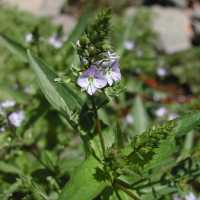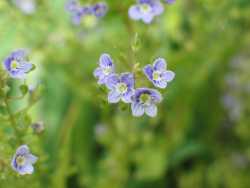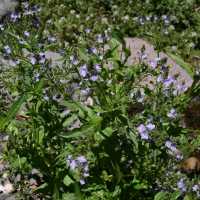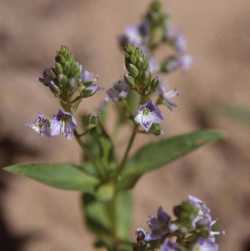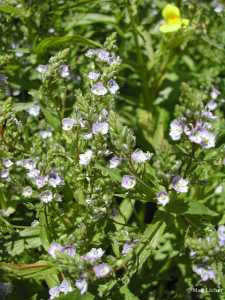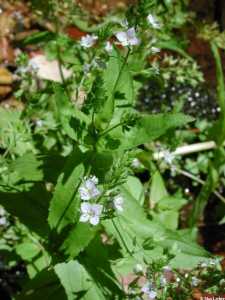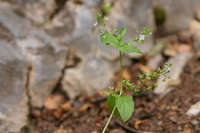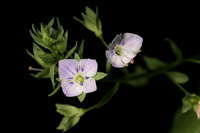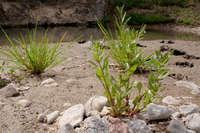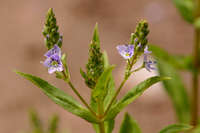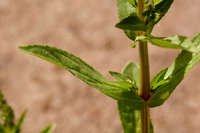I have this species from three of our southeastern counties where I found it on the borders of small streams and in the outlets of springs. Scott McCoy also found it along Crooked Creek in Marion County about three miles northwest of Indianapolis.
Duration: Perennial
Nativity: Non-native
Lifeform: Forb/Herb
General: Perennial herb, 10-60 cm tall, from creeping rhizomes; stems generally decumbent, rooting at lower nodes, simple to many-branching from base, glabrous.
Leaves: Opposite along the stems, with clasping bases; lowest leaves sometimes on short petioles; blades elliptic to ovate, 2-8 cm long and 5-40 mm wide, light green, with entire to serrate margins.
Flowers: Lavender, in racemes emerging from the axils of upper leaves; each raceme has 30 or more flowers, each on an upcurved or ascending pedicel 4-8 mm long; sepals 4 per flower, lanceolate to elliptic, 3-6 mm long; corolla 5-10 mm wide, irregularly 4-lobed, the uppermost lobe the largest and the lower lobe smallest, pale lavender-blue, with purple nectar guidelines.
Fruits: Capsule ovoid, 3-4 mm high and almost as wide, with an inconspicuous notch at the tip and a persistent style 2-3 mm long; splitting open to release many tiny seeds less than 0.5 mm long.
Ecology: Found in wet meadows, streambanks, and along slow streams, from 1,500-7,000 ft (457-2134 m); flowers March-September.
Distribution: Native to Europe, Asia, and Africa; now widely naturalized in the New World.
Notes: This is a common perennial herb found along the margins perennial streams throughout the West. It is considered aquatic or semi-aquatic and generally found within a meter or so of the stream edge, or even emerging from shallow, slow-moving water. Look for the opposite leaves with smooth or slightly toothed edges and bases that clasp the stem; the stems which often creep along the ground and root at the nodes and then turn upward to be erect to ascending; and the small lavender flowers in racemes that emerge from the leaf axils. Veronica americana is similar but all the leaves have petioles (V. anagallis-aquatica sometimes has a few petiolate leaves near the bottom of the stems but the upper leaves are sessile and usually clasping). Seinet now lumps this species and V. catenata into V. grandiflora, but at the time of this description, neither Tropicos nor any recent regional floras recognize that change. V. catenata has narrower lanceolate leaves; smaller flowers with corollas 3-5 mm wide; racemes with fewer than 25 flowers; and pedicels that are straight or spreading.
Ethnobotany: Leaves are edible raw or cooked; used medicinally to improve appetite, as a blood tonic, to improve urine flow, and to treat burns and skin ulcers.
Etymology: Veronica is named for Saint Veronica; anagallis-aquatica means water-pimpernel, and is named for its resemblance to the genus Anagallis, common name pimpernel, in the Primrose family.
Synonyms: Many, see Tropicos
Editor: SBuckley 2010, AHazelton 2017
Fibrous-rooted, probably biennial or short-lived perennial, ±erect, 2-10 dm, glabrous, or slightly glandular in the infl; lvs all opposite, mostly elliptic or elliptic-ovate to elliptic-oblong, sessile and mostly clasping (or the lower with subpetiolar base), 2-10 x 0.7-5 cm, 1.5-3 times as long as wide, sharply serrate to entire (sterile autumnal shoots with more rounded and petiolate lvs); racemes axillary, pedunculate, many-fld; sep highly variable in form and size; cor rather light blue, 5-8 mm wide; mature pedicels generally strongly ascending or upcurved, 3-8 mm; fr turgid, 2.5-4 mm, scarcely notched, nearly or fully as wide; style 1.5-2.5 mm; seeds numerous, 0.5 mm or less; 2n=36. Along ditches and slowly moving streams, or in other wet places, frequently in shallow water, but largely emersed; native of Eurasia, now established throughout our range. May-Sept. (V. glandifera) Hybridizes with no. 18 [Veronica catenata Pennell].
Gleason, Henry A. & Cronquist, Arthur J. 1991. Manual of vascular plants of northeastern United States and adjacent Canada. lxxv + 910 pp.
©The New York Botanical Garden. All rights reserved. Used by permission.


